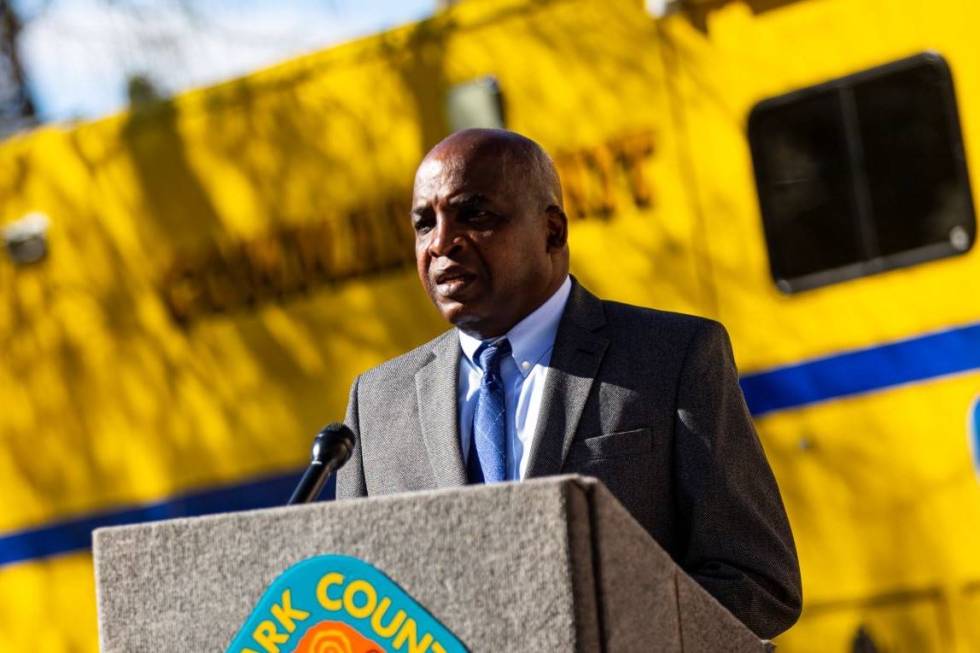‘Several weeks’ until those 65 to 69 get vaccine, official says

The head of the Southern Nevada Health District said Wednesday it will be “several weeks” before COVID-19 vaccine becomes available to those in the general public between the ages of 65 and 70.
In Clark County, shots of vaccine currently are being given to those 70 and older, as well as to occupational groups ranging from health care workers to elected officials to court personnel.
The county is receiving 22,000 doses of vaccine a week from the federal government. There are more than 228,000 people in the county 70 and older, according to census estimates, though not all will choose to be inoculated.
Unless the county receives a larger allocation of vaccine, it will be “several weeks before we can actually move into the next group” eligible for inoculation, said Dr. Fermin Leguen, acting chief health officer for the health district.
“It is not because we don’t want to. It’s just because there is no vaccine,” Leguen said in an afternoon online briefing.
His comments followed a separate briefing in which state officials said they were encouraged by the Biden administration’s commitment to increase vaccine allocation to the states. The federal ordering system already indicates a larger allocation for Nevada, which has been receiving about 36,000 doses a week. The officials did not specify the amount of the increase.
Eligibility for vaccine
Because the vaccine supply is limited, Nevada, like other states, has created a prioritization system for who should receive the vaccine first.
Vaccine first was made available in mid-December to hospital workers, followed by other front-line health care workers and emergency responders, along with staff and residents in long-term care facilities such as nursing homes.
In mid-January, vaccinations became available to those 70 and older. A few days later, the health district’s website showed “frontline community support” occupations also were eligible for the vaccine.
This broad swath of occupations, according to the state’s vaccine playbook, includes everyone from teachers to essential transportation workers to mortuary personnel.
However, health district officials said Wednesday that they had made a cutoff point in the group so that not all within “frontline community support” currently are eligible. This was to allow vaccination efforts to focus on those who are considered a higher priority who still needed to be inoculated, they said.
The cutoff comes after a group titled “continuity of governance,” which includes elected officials and their staff. Below the cutoff point within “frontline community support” are essential public transportation workers, the remainder of the public health workforce and mortuary services personnel.
This means that essential transportation workers will be the occupational group next in line for vaccine, according to Stephanie Bethel, a spokeswoman for the district. This may not happen concurrently with when those 65 to 69 become eligible for the vaccine.
“We have to remain flexible due to vaccine supply,” Bethel said in an email.
Health district official JoAnn Rupiper said that with a higher allocation of vaccine, the current vaccine clinics could administer 50,000 vaccinations a week, and that by March, that number could grow to 100,000.
Bottom ranking
Nevada ranks near the bottom of the list in terms of vaccine delivered to the state and vaccine doses administered per capita, according to data from the Centers for Disease Control and Prevention.
It ranks second to last in terms of vaccine distributed to the state on a per capita basis. It ranks third to last in vaccine doses administered per capita. Across the state, 195,000 doses of vaccine have been administered.
Nevada leads the western Region 9 in terms of percent of doses delivered that have been administered, or shots in arms, said Caleb Cage, who directs the state’s COVID-19 response.
The state has administered 51.5 percent of the vaccine it has received, ahead of California at 47.3 percent, Arizona at 46.3 percent and Hawaii at 44.9 percent, according to CDC data.
More than 50 percent of the doses that have yet to be administered are tied up in a federal program for vaccinating residents and staff at long-term care facilities in Nevada, Candice McDaniel, a bureau chief with the state Department of Health and Human Services, said.
State officials said they have ordered vaccine up to the federal allocation cap on first doses but are timing the ordering of second doses until they are needed because of the rigorous requirements for storing and handling vaccines needing ultra-cold storage.
Contact Mary Hynes at mhynes@reviewjournal.com or 702-383-0336. Follow @MaryHynes1 on Twitter. Staff writer Michael Scott Davidson contributed to this report.